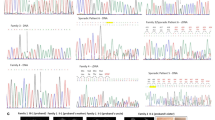Abstract
Cerebral cavernous malformations (CCMs) are vascular abnormalities that may cause seizures, headaches, intracerebral hemorrhages, and focal neurological deficits; they can also be clinically silent and occur as a sporadic or an autosomal dominant condition. Three genes have been identified as causing familial CCM: KRIT1/CCM1, MGC4607/CCM2, and PDCD10/CCM3, mapping, respectively, on chromosomes 7q, 7p, and 3q. Here, we report an Italian family affected by CCM due to a MGC4607 gene mutation, on exon 4. All the affected subjects suffered from seizures, and some of them underwent surgery for removal of a cavernous angioma. Brain MRI showed multiple lesions consistent with CCMs in all patients. Spinal and cutaneous cavernous angiomas were present too. This report underlines the need for a careful interdisciplinarity among neurologists, neuroradiologists, neurosurgeons, geneticists, ophthalmologists, and dermatologists for a total evaluation of the different manifestations of familial CCM. This points out that only referral centers are organized to offer a multidisciplinary management of this disease.





Similar content being viewed by others
References
Akers AL, Johnson E, Steinberg GK, Zabramski JM, Marchuk DA (2009) Biallelic somatic and germline mutations in cerebral cavernous malformations (CCMs): evidence for a two-hit mechanism of CCM pathogenesis. Hum Mol Genet 18(5):919–930
Bacigaluppi S, Retta SF, Pileggi S et al (2013) Genetic and cellular basis of cerebral cavernous malformations: implications for clinical management. Clin Genet 83(1):7–14
Bergametti F, Denier C, Labauge P et al (2005) Mutations within the programmed cell death 10 gene cause cerebral cavernous malformations. Am J Hum Genet 76:42–51
Cavé-Riant F, Denier C, Labauge P et al (2002) Spectrum and expression analysis of KRIT1 mutations in 121 consecutive and unrelated patients with Cerebral Cavernous Malformations. Eur J Hum Genet 10:733–740
Cigoli MS, Avemaria F, De Benedetti S (2014) PDCD10 Gene mutations in multiple cerebral cavernous malformations PDCD10 gene mutations in multiple cerebral cavernous malformations. PLoS ONE 9(10):e110438
D'Angelo R, Scimone C, Calabrò M, Schettino C, Fratta M, Sidoti A (2013) Identification of a novel CCM2 gene mutation in an Italian family with multiple cerebral cavernous malformations and epilepsy: a causative mutation? Gene 519:202–207
Denier C, Labauge P, Brunereau L et al (2004) Clinical features of cerebral cavernous malformations patients with KRIT1 mutations. Ann Neurol 55:213–220
Dobyns WB, Michels VV, Groover RV et al (1987) Familial cavernous malformations of the central nervous system and retina. Ann Neurol 21:578–583
Draheim KM, Fisher OS, Boggon TJ, Calderwood DA (2014) Cerebral cavernous malformation proteins at a glance. J Cell Sci 127:701
Kattapong VJ, Hart BL, Davis LE (1995) Familial cerebral cavernous angiomas: clinical and radiologic studies. Neurology 45:492–497
Laberge-le Couteulx S, Jung HH, Labauge P et al (1999) Truncating mutations in CCM1, encoding KRIT1, cause hereditary cavernous angiomas. Nat Genet 23:189–193
Li D, Hao SY, Jia GJ, Wu Z, Zhang LW, Zhang JT (2014) Hemorrhage risks and functional outcomes of untreated brainstem cavernous malformations. J Neurosurg 121(1):32–41
Liquori CL, Berg MJ, Siegel AM et al (2003) Mutations in a gene encoding a novel protein containing a phosphotyrosine-binding domain cause type 2 cerebral cavernous malformations. Am J Hum Genet 73:1459–1464
Mason I, Aase JM, Orrison WW, Wicks JD, Seigel RS, Bicknell JM (1988) Familial cavernous angiomas of the brain in an hispanic family. Neurology 38:324–326
Miller SA, Dykes DD, Polesky HF (1988) A simple salting out procedure for extracting DNA from human nucleated cells. Nucleic Acids Res 16:1215
Mosca L, Pileggi S, Avemaria F et al (2012) De novo MGC4607 gene heterozygous missense variants in a child with multiple cerebral cavernous malformations. J Mol Neurosci 47:475–480
Moussa R, Harb A, Menassa L et al (2006) Etiologic spectrum of intracerebral hemorrhage in young patients. Neurochirurgie 52(2–3 Pt 1):105–109
Pileggi S, Buscone S, Ricci C et al (2010) Genetic variations within KRIT1/CCM1, MGC4607/CCM2 and PDCD10/CCM3 in a large Italian family harbouring a krit1/CCM1 mutation. J Mol Neurosci 42:235–242
Raychaudhuri R, Batjer HH, Awad IA (2005) Intracranial cavernous angioma: a practical review of clinical and biological aspects. Surg Neurol 63:319–328
Sahoo T, Johnson EW, Thomas JW et al (1999) Mutations in the gene encoding KRIT1, a Krev-1/rap1a binding protein, cause cerebral cavernous malformations (CCM1). Hum Mol Genet 8:2325–2333
Simard JM, Garcia-Bengochea F, Ballinger WE Jr, Mickle JP, Quisling RG (1986) Cavernous angioma: a review of 126 collected and 12 new clinical cases. Neurosurgery 18:162–172
Steichen-Gersdorf E, Felber S, Fuchs W, Russeger L, Twerdy K (1992) Familial cavernous angiomas of the brain: observations in a four generation family. Eur J Pediatr 151:861–863
Uhlik MT, Abell AN, Johnson NL et al (2003) Rac-MEKK3-MKK3 scaffolding for p38 MAPK activation during hyperosmotic shock. Nat Cell Biol 5:1104–1110
Voigt K, Yasargil MG (1976) Cerebral cavernous haemangiomas or cavernomas. Incidence, pathology, localization, diagnosis, clinical features, and treatment. Review of the literature and report of an unusual case. Neurochirurgia 19:59–68
Zhou X, Izumi Y, Burg MB, Ferraris JD (2011) Rac1/osmosensing scaffold for MEKK3 contributes via phospholipase C-gamma1 to activation of the osmoprotective transcription factor NFAT5. Proc Natl Acad Sci U S A 108:12155–12160
Acknowledgments
We wish to thank the family for their cooperation. S.B. was supported in 2013–2014 by a Postdoctoral Fellowship Grant by the U. Veronesi Foundation (ONLUS).
Conflict of Interest
The authors declare that they have no conflict of interest.
Author information
Authors and Affiliations
Corresponding author
Rights and permissions
About this article
Cite this article
Cigoli, M.S., De Benedetti, S., Marocchi, A. et al. A Novel MGC4607/CCM2 Gene Mutation Associated with Cerebral Spinal and Cutaneous Cavernous Angiomas. J Mol Neurosci 56, 602–607 (2015). https://doi.org/10.1007/s12031-015-0555-0
Received:
Accepted:
Published:
Issue Date:
DOI: https://doi.org/10.1007/s12031-015-0555-0




